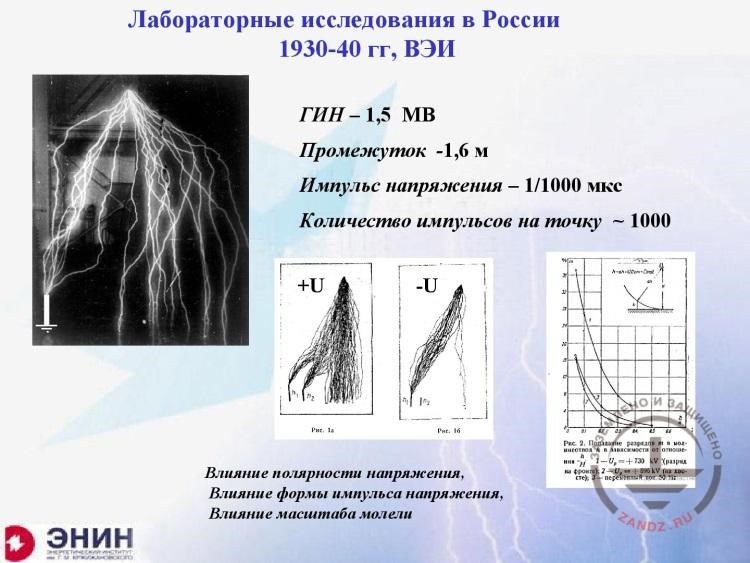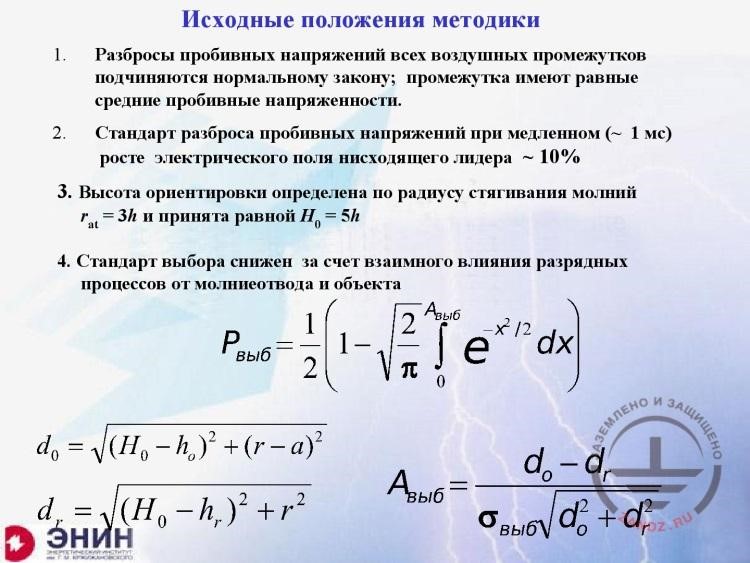The nineteenth webinar of "Earthing and Lightning Protection: Design Issues and Problems" series.
Webinar text. Page 2
Fast navigation by slides:
<< Page 1:
1. Origin of lightning protection zones
2. Protection against the lightning current interference
3. Methods for recording the lightning strike point
4. What was the originators' way of thinking?
5. Protection radius of lightning arresters
6. Research of I.S. Stekolnikov
7. Preceding lightning arresters
8. First protection zones
Page 2:
9. Laboratory research in Russia
10. Protection zone according to Akopyan
11. Particular configuration of the protection zone
12. How to determine the protection zone dimensions?
13. Searching for the orientation mechanism
14. Determining protection zones in the laboratory
15. Probabilistic method, ENIN modification
16. Method assumptions
Page 3: >>
17. CIGRE data for high-voltage power lines
18. What problems do protection zones for lightning arresters entail?
19. Multiple lightning arresters
20. IEC shielding angle method
21. What tasks are solved in the laboratory today?
22. Negative spark of 30 m long
23. Report conclusions
24. Questions and answers
| Лабораторные исследования в России, 1930-40 гг, ВЭИ | Laboratory research in Russia, the 1930–40s, VEI |
| ГИН – 1,5 МВ | Pulse voltage generators — 1.5 MV |
| Промежуток – 1,6 м | Gap — 1.6 m |
| Импульс напряжения – 1/1000 мкс | Voltage pulse — 1/1,000 mcs |
| Количество импульсов на точку ~ 1000 | Number of pulses per point ~ 1,000 |
| Рис. 1а | Fig. 1a |
| Рис. 1б | Fig. 1b |
| Влияние полярности напряжения, | Effect of voltage polarity, |
| Влияние формы импульса напряжения, | Effect of voltage pulse shape, |
| Влияние масштаба модели | Effect of model scale |
| Рис. 2. Попадание разрядов в молниеотвод в зависимости от отношения h/H 1-UP = +730 kV (разряд на фронте), 2-UP = + 596 kV (на хвосте); 3 – переменный ток 50 Гц | Fig. 2. Discharge strikes into the lightning arrester depending on ratio h/H 1-UP = +730 kV (discharge in the front), 2-UP = + 596 kV (in the tail); 3 – alternating current of 50 Hz |
– The serious work was started in the end of the 1930s, in Moscow, in the All-Union Electrotechnical Institute. Artur Akopyan, a very decent researcher, guided this work. This is what he did: he used a pulse generator; in the gaps of about 1.5 meters long, the model of a facility was installed, and hundreds of sparks were sent that passed along different paths. The portion of these sparks got into the lightning arrester, the other portion got into the facility, and the third part got into the earth, and the models were thus tested. What did Artur see but did not want to understand? He saw the following. It turns out that, with the positive and negative voltages, the discharges had completely different paths. Almost all negative sparks got into the lightning arrester, while the positive sparks got God knows where. Finally, when they used the pulse generator that provided a pulse with a steep front, the protection zones of one type were obtained. But when, instead of such generator, they used a source of constant voltage or industrial frequency voltage, the protection zones were different. And they have made a simple conclusion: it is better to choose the worst zones, as the worst zone provides a positive voltage pulse with the short front, and we will use these zones. And they used these zones. And nobody knows the reason why exactly these zones but not any other.
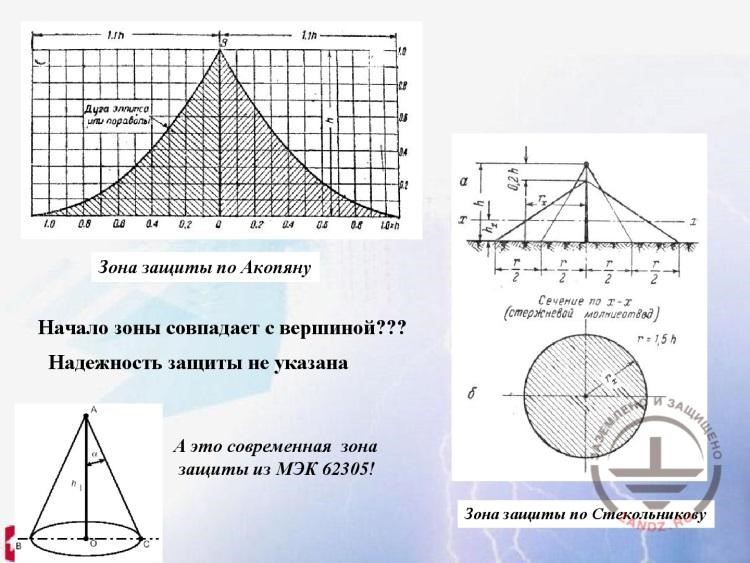
Protection zone according to Akopyan
| Дуга эллипса или параболы | Ellipse or parabola arc |
| Зона защиты по Акопяну | Protection zone according to Akopyan |
| Начало зоны совпадает с вершиной??? | Beginning of the zone coincides with the top??? |
| Надежность защиты не указана | Protection reliability is not shown |
| А это современная зона защиты из МЭК 62305! | And this is a current protection zone from IEC 62305! |
| Сечение по x-x (стержневой молниеотвод) | Cross-section along x–x (lightning rod) |
| Зона защиты по Стекольникову | Protection zone according to Stekolnikov |
– As a result of these experiments, the protection zones were generated with the envelope curves of this section drawn for the unclear reason as either parabola or hyperbola. But the most important point is that this zone began from the top of the lightning arrester in any case. There was a hard and very unpleasant discussion about how to draw the boundary for this zone: as a straight line as shown here or as a hyperbola or parabola, or a curve, as shown by Akopyan. The discussion had been active for several years. It ended up with nothing, but both zones protruded from the top of the lightning arrester. And today, the IEC protection zones also protrude from the top of the lightning arrester. Why do they protrude from the top of the lightning arrester? Let's reason this. Imagine that I have installed a lightning arrester having some height. Near the arrester, I have installed one more stick of about the same height and called it the facility as opposed to the lightning arrester. Their heights are about the same. What will happen then? A half of strikes will get into the stick labelled with L (lightning arrester), and the second half of strikes will get into the stick having almost the same height, which was called "a facility". And what will be their protection efficiency? 0.5. It means that if I want the protection reliability more than 0.5, e.g., 0.9 or 0.99 or 0.99, I have to make the facility lower than the lightning arrester, but it is surely more correct to place the lightning arrester over the facility.
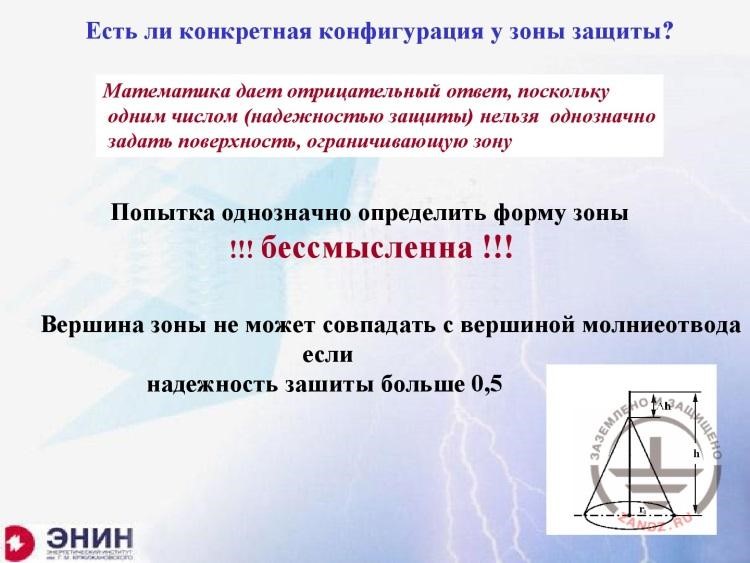
Does the protection zone have a specific configuration?
| Есть ли конкретная конфигурация у зоны защиты? | Does the protection zone have a specific configuration? |
| Математика дает отрицательный ответ, поскольку одним числом (надежностью защиты) нельзя однозначно задать поверхность, ограничивающую зону | Mathematics provides a negative answer, because one value (reliability protection) cannot precisely define the surface that delineates the zone |
| Попытка однозначно определить форму зоны !!! бессмысленна !!! | An attempt to precisely define the zone shape is !!! senseless !!! |
| Вершина зоны не может совпадать с вершиной молниеотвода если надежность защиты больше 0,5 | The zone top cannot coincide with the lightning arrester top if the protection reliability is more than 0.5 |
– Then, the analysis started: can we generate the protection zone? We got used to that the protection zone is built as a cone. Why should it be in the form of a cone? Why cannot we make a protection zone of any other configuration, e.g., rectangular? What do we know about the protection zone? The only thing is known to us is that the space it delineates is protected against the lightning with a certain, specific reliability. But if I determine the space using only one value, I cannot determine the shape of such space. Generally, the shape corresponding to the reliability may be any that is descending from the top. And we understood that the protection zone was a formality, and it was not clear what to do with it.
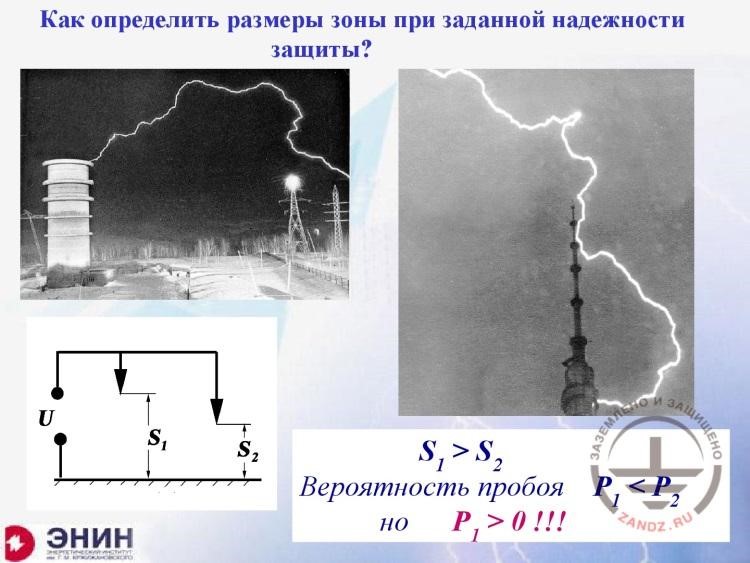
How can we determine the protection zone dimensions?
| Как определить размеры зоны при заданной надежности защиты? | How can we determine the protection zone dimensions? |
| Вероятность пробоя | Breakthrough probability |
| но | but |
– The issue of determining the protection zones occurred again and with the strong wording, in the 1960s. In the 1960s, it became clear that we had an opportunity to create generators with the voltage of 3 million V, 5 million V, or 7 million V instead of 1.5 million V as Artur Akopyan did. And it became clear that those crazy sparks in terms of their length of dozens meters go by undefined paths, but not by the shortest distances as it was believed in the 1930s. Look at these two pictures. On one side, a well-known photograph of the Ostankino Tower is shown, wherein the lightning missed the top for 202 meters, and on the other side, the discharge in Novosibirsk that was obtained in the voltage generator of 5 million V is provided, wherein the spark did not pass along the shortest path to the earth by breaking through 34 meters, but flew away for 150 meters and got into the power lines located at the distance of more than 100 meters from this generator. They had to do something with it. They had to understand what exactly determines the spark path and how it is formed.
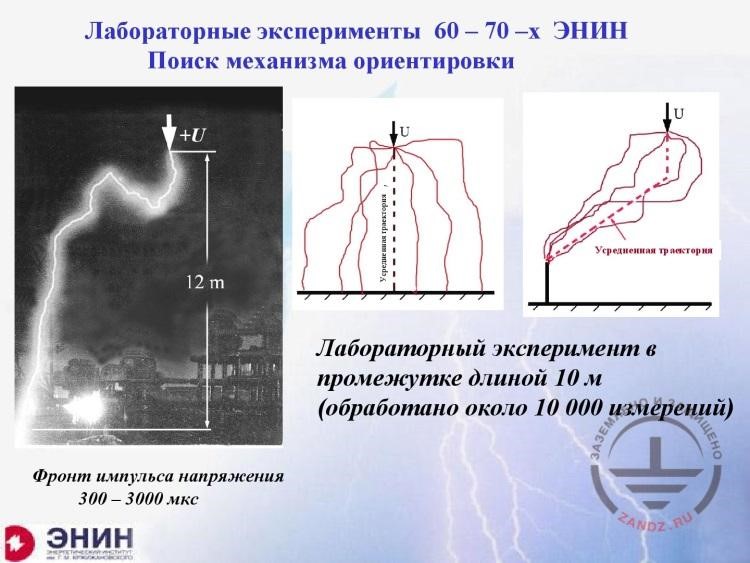
Searching for the orientation mechanism
| Лабораторные эксперименты 60-70-х ЭНИН | Laboratory experiments of the 60–70s in ENIN |
| Поиск механизма ориентировки | Searching for the orientation mechanism |
| Фронт импульса напряжения 300 -3000 мкс | Voltage pulse front is 300–3,000 mcs |
| Лабораторный эксперимент в промежутке длиной 10 м (обработано около 10 000 измерений) | Laboratory experiment in the gap of 10 m (about 10,000 measurements were processed) |
– And in the 1960s, a large series of experiments was conducted that was not aimed at determining the protection zones. They wanted to understand how the lightning discharge chooses its path. And the following idea came up: take a lightning path or take a path of a spark length (you can see the path of the long spark that was obtained in the test bench in Leningrad, which was not named Saint Petersburg yet, 12 meters long. You can see that it is randomly curved). And then, they thought: let's make many paths, capture them, make cross-sections of these paths, and calculate the "+" deviations to the one side, and the "-" deviations to the other side. Then, if all of those paths are formed randomly, the averaged path will be a simple vertical line. And if these paths have some targeted deviations, initially this path will be vertical, and then it will begin deviating to the side where, for example, the lightning arrester is installed.
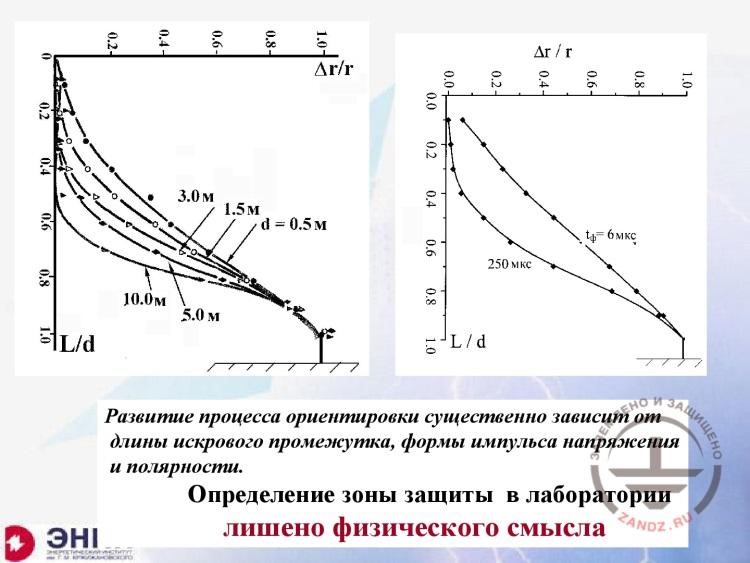
Determining protection zones in the laboratory
| 10.0 м | 10.0 m |
| 3.0 м | 3.0 m |
| 1.5 м | 1.5 m |
| 5.0 м | 5.0 m |
| d = 0.5 м | d = 0.5 m |
| 250 мкс | 250 mcs |
| tФ = 6 мкс | tF = 6 mcs |
| Развитие процесса ориентировки существенно зависит от длины искрового промежутка, формы импульса напряжения и полярности. | Development of the orientation process depends heavily on the spark gap length, voltage pulse, and polarity. |
| Определение зоны защиты в лаборатории лишено физического смысла | Determination of the protection zone in the laboratory makes no sense in terms of physics |
– The second point that was defined is as follows: this targeted deviation during the laboratory experiments varied depending on the experimental conditions. It varied as follows: the longer the gap, the more part of the averaged path was vertical and only after that the deviation began. Here is a gap of 10 meters and there is a gap of 0.5 meter. Can you see how they differ? This one goes in a targeted manner, and this is the averaged path that goes like this. And it turns out that if we conduct the experiments in different scales in the laboratory, we will obtain different results. But that is not all. Another result was also obtained. It turned out that the nature of this path depends on the nature of the voltage pulse. This voltage pulse has got a very short front of about 5 mcs. The path intentionally goes directly to the lightning arrester. And here, I have made a shallow pulse. It has got a 200 mcs front. Can you see that? If I conducted such experiments with the negative polarity, I would have obtained more different values. And based on this, we can only make one conclusion: we can qualitatively study the process in laboratory, but we cannot obtain the protection zone in the laboratory and transfer it to the real life because the result depends heavily on the conditions of the experiment.
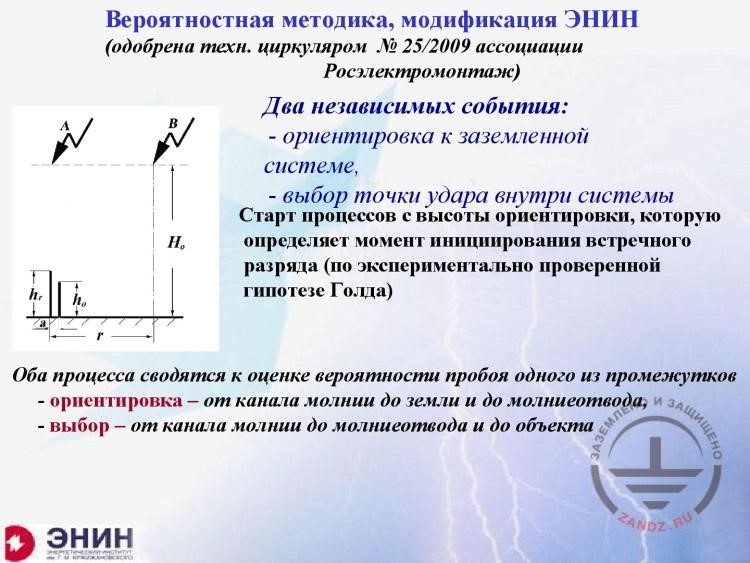
Probabilistic method modified by ENIN
| Вероятностная методика, модификация ЭНИН | Probabilistic method modified by ENIN |
| (одобрена техн. Циркуляром № 25/2009 ассоциации Росэлектромонтаж) | (approved by Technical Bulletin No. 25/2009 of the Roselectromontazh association) |
| Два независимых события: - ориентировка к заземленной системе, - выбор точки удара |
Two independent events: - orientation towards the earthed system, - choosing the strike point |
| Старт процессов с высоты ориентировки, которую определяет момент инициирования встречного разряда (по экспериментально проверенной гипотезе Голда) | Start of processes from the orientation height, which is determined by the time of initiating the opposed discharge (according to the experimentally approved Gold’s theory) |
| Оба процесса сводятся к оценке вероятности пробоя одного из промежутков - ориентировка – от канала молнии до земли и до молниеотвода, - выбор – от канала молнии до молниеотвода и до объекта |
Both processes boil down to the probability estimation of breakthrough of any gap - orientation: from the lightning channel to the earth and to the lightning arrester, - choosing: from the lightning channel to the lightning arrester and to the facility |
– We had to do something, so we had the following idea in our institute: we had decided to make a computational model on the basis of our experiments, which could have defined the protection zones with any significance while using a minimum amount of available experimental data for this. What did we think about? We have done the following thing: the lightning orientation process begins with some height that is called an orientation height and that is, according to the approved Gold's hypothesis, begins in the point when the opposed discharge starts from the top of the lightning arrester. This is the first point. The second point is that the process goes as two independent events. The first event is associated with that the general lightning path is chosen. Where will the lightning go? Will it get into the "lightning arrester – facility" system or to the earth? And the second process relates to the lightnings that are oriented this way. During this process we called a choosing process, a point is chosen on the surface of the lightning arrester or on the surface of the facility.
| Исходные положения методики | Initial method provisions |
| 1. Разбросы пробивных напряжений всех воздушных промежутков подчиняются нормальному закону; промежутка имеют равные средние пробивные напряженности. | 1. Dispersions of breakthrough voltages for all air gaps are governed by the normal law; the gaps have got equal average breakthrough strengths. |
| 2. Стандарт разброса пробивных напряжений при медленном (~ 1 мс) росте электрического поля нисходящего лидера ~ 10%. | 2. Standard of dispersion of breakthrough voltages upon a slow (~ 1 ms) growth of the electrical field of a descending leader ~ 10%. |
| 3. Высота ориентировки определена по радиусу стягивания молний rat = 3h и принята равной H0 = 5h | 3. Orientation height is determined according to the radius of the lightning attraction rat = 3h and is assumed as H0 = 5h |
| 4. Стандарт выбора снижен за счет взаимного влияния разрядных процессов от молниеотвода и объекта | 4. Standard of dispersion is reduced due to the mutual influence of the discharge processes from the lightning arrester and the facility |
<< Previous page
slides from 1 to 8
Next page >>
slides from 17 to 23 + Questions and answers
Related Articles:


 Lightning Protection of Large Territories: Parks, Grounds, Plant Territories. Page 1
Lightning Protection of Large Territories: Parks, Grounds, Plant Territories. Page 1
 Lightning Protection of Large Territories: Parks, Grounds, Plant Territories. Page 2
Lightning Protection of Large Territories: Parks, Grounds, Plant Territories. Page 2
 Lightning Protection of Large Territories: Parks, Grounds, Plant Territories. Page 3
Lightning Protection of Large Territories: Parks, Grounds, Plant Territories. Page 3


